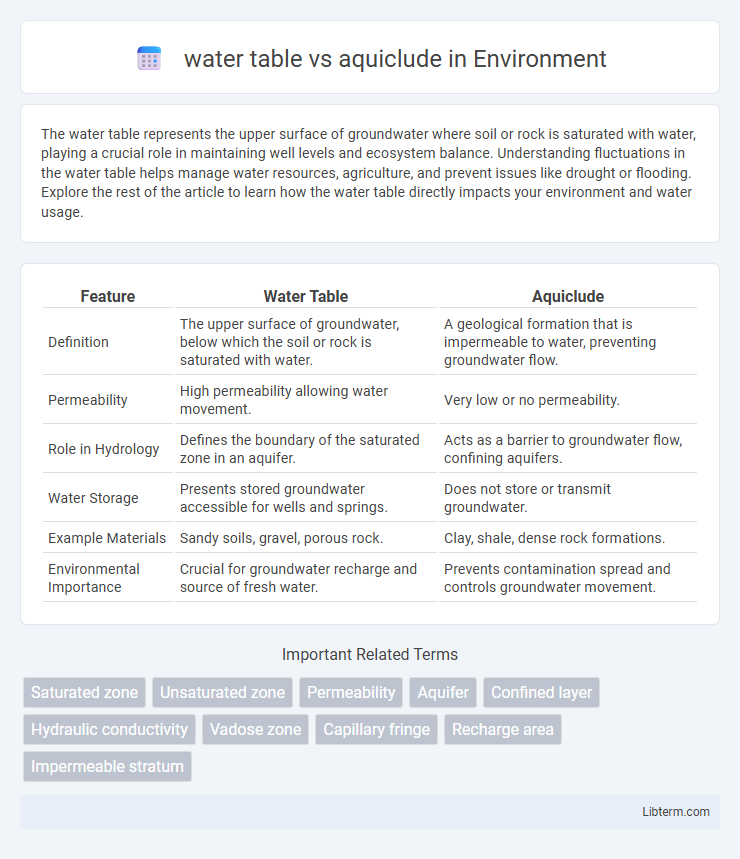The water table represents the upper surface of groundwater where soil or rock is saturated with water, playing a crucial role in maintaining well levels and ecosystem balance. Understanding fluctuations in the water table helps manage water resources, agriculture, and prevent issues like drought or flooding. Explore the rest of the article to learn how the water table directly impacts your environment and water usage.
Table of Comparison
| Feature | Water Table | Aquiclude |
|---|---|---|
| Definition | The upper surface of groundwater, below which the soil or rock is saturated with water. | A geological formation that is impermeable to water, preventing groundwater flow. |
| Permeability | High permeability allowing water movement. | Very low or no permeability. |
| Role in Hydrology | Defines the boundary of the saturated zone in an aquifer. | Acts as a barrier to groundwater flow, confining aquifers. |
| Water Storage | Presents stored groundwater accessible for wells and springs. | Does not store or transmit groundwater. |
| Example Materials | Sandy soils, gravel, porous rock. | Clay, shale, dense rock formations. |
| Environmental Importance | Crucial for groundwater recharge and source of fresh water. | Prevents contamination spread and controls groundwater movement. |
Introduction to Groundwater Systems
The water table represents the upper surface of the zone of saturation where groundwater fully saturates soil and rock, playing a critical role in aquifer dynamics. An aquiclude is a geological formation composed of impermeable materials such as clay or dense rock that restricts the flow of groundwater, effectively separating different aquifer layers. Understanding the interaction between the water table and aquicludes is essential for managing groundwater resources, predicting recharge areas, and preventing contamination in subsurface water systems.
Defining the Water Table
The water table is the upper surface of the zone of saturation where groundwater fully saturates soil or rock, marking the boundary between the vadose zone and the saturated zone. It fluctuates based on precipitation, topography, and human activity, influencing groundwater availability and well depth. In contrast, an aquiclude is a geological formation composed of impermeable materials such as clay or dense rock that prevent water flow, effectively confining water below the water table and impacting groundwater movement.
Understanding Aquicludes
An aquiclude is a geological formation that acts as an impermeable barrier, preventing the flow of groundwater between adjacent aquifers, thereby influencing the position and behavior of the water table above it. Unlike permeable layers that allow water movement, aquicludes maintain distinct groundwater zones by restricting vertical water migration, essential for managing groundwater resources. Understanding aquicludes helps in predicting water availability and protecting aquifers from contamination.
Key Differences: Water Table vs. Aquiclude
The water table represents the upper surface of the saturated zone where groundwater pressure equals atmospheric pressure, marking the boundary between saturated and unsaturated soil layers. An aquiclude is a geological formation composed of impermeable materials like clay or dense rock that restrict water flow, preventing the transmission of groundwater. Key differences include the water table's role as a dynamic boundary influenced by recharge and discharge, while an aquiclude serves as a static barrier that confines or isolates aquifers.
Formation and Characteristics of Water Tables
Water tables form the upper surface of groundwater where soil or rock is fully saturated, fluctuating in response to precipitation and topography. Aquicludes consist of impermeable layers like clay or dense rock that prevent water flow, effectively confining the water table above or below them. The water table's position and level are dynamic, controlled by the porosity and permeability of surrounding materials, contrasting with the static barrier posed by aquicludes.
Types and Properties of Aquicludes
Aquicludes are geological formations characterized by their extremely low permeability, preventing significant water flow and effectively isolating aquifers, unlike the water table which marks the upper surface of the saturated zone in an aquifer. Types of aquicludes include clay, shale, and dense crystalline rocks, all possessing fine-grained textures and high compaction that inhibit water movement. Their key properties, such as high porosity but negligible permeability, make aquicludes crucial in confining groundwater and maintaining pressure within confined aquifers.
The Role of Permeability and Porosity
The water table marks the upper surface of saturated soil or rock where groundwater is fully filling the pore spaces, highlighting high porosity and permeability essential for water movement. In contrast, an aquiclude exhibits extremely low permeability despite potentially having porosity, acting as a barrier that prevents water flow and confines groundwater within aquifers. Understanding the distinct roles of permeability and porosity in these geological features is crucial for effective groundwater management and resource extraction.
Impact on Groundwater Movement
The water table defines the upper surface of the saturated zone where groundwater pressure is equal to atmospheric pressure, allowing for significant movement and storage of groundwater. In contrast, an aquiclude is a geological formation with extremely low permeability that restricts or prevents groundwater flow, acting as a barrier within the subsurface. The presence of an aquiclude can cause groundwater to accumulate above it, influencing the direction and rate of groundwater movement and creating confined or perched water tables.
Practical Significance in Water Resource Management
The water table marks the upper boundary of saturated groundwater, crucial for determining well depths and sustainable extraction rates in water resource management. An aquiclude acts as an impermeable layer that restricts water flow, influencing groundwater recharge zones and protecting aquifers from contamination. Understanding the interaction between the water table and aquicludes aids in designing effective groundwater extraction and pollution prevention strategies.
Summary: Water Table and Aquiclude Compared
The water table represents the upper surface of saturated ground where soil and rock are fully filled with water, serving as a key indicator of groundwater levels. An aquiclude is a geological formation consisting of impermeable rock or sediment that restricts water flow, effectively acting as a barrier within aquifers. Understanding the interactions between the water table and aquicludes is essential for managing groundwater resources and predicting the behavior of subsurface water movement.
water table Infographic

 libterm.com
libterm.com